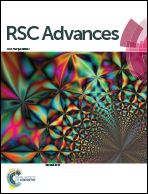Co-production of microbial oil and exopolysaccharide by the oleaginous yeast Sporidiobolus pararoseus grown in fed-batch culture†
Abstract
The production cost of microbial oil was reduced by improving the exopolysaccharide (EPS) production to share the production cost using Sporidiobolus pararoseus JD-2. Batch fermentation demonstrated that S. pararoseus JD-2 has the potential to co-produce oil and EPS with 120 g L−1 glucose, 20 g L−1 corn steep liquor and 10 g L−1 yeast extract as carbon and nitrogen sources. Using fed-batch fermentation for 72 h resulted in oil and EPS production of 41.6 ± 2.5 g L−1 and 13.1 ± 0.6 g L−1 with the productivity of 0.58 g L−1 h−1 and 0.182 g L−1 h−1, respectively. The fat soluble nutrients in the oil were studied, indicating that it was constituted of 79.19% unsaturated fatty acids and contained 505 mg per kg-oil of carotenoids. Moreover, the EPS contained only one type of polysaccharide; the main monosaccharide compositions were galactose, glucose and mannose in a proportion of 16 : 8 : 1. These results implied that EPS produced by S. pararoseus JD-2 was a new type of EPS.



 Please wait while we load your content...
Please wait while we load your content...